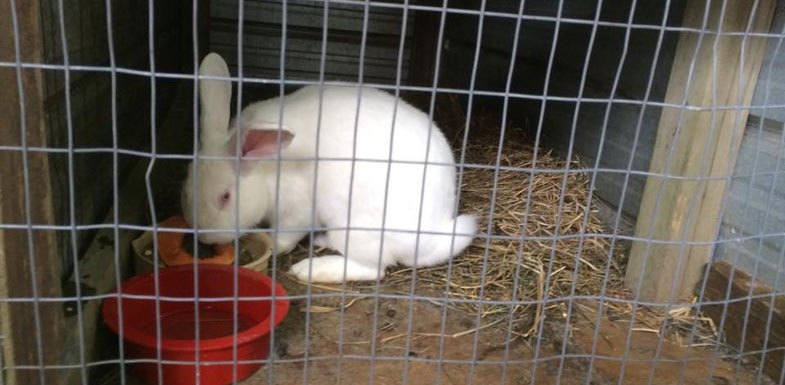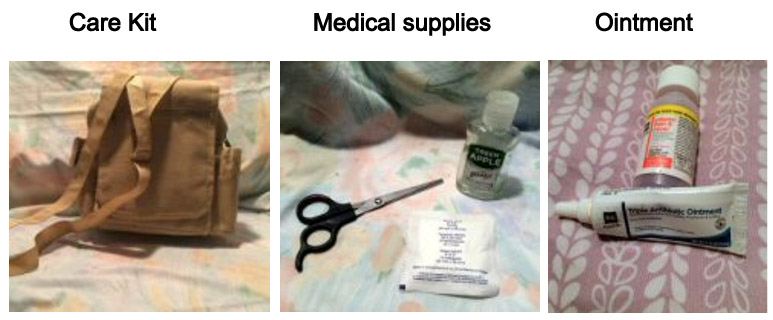As with all animals, rabbits are no exception to the rule of being dependent on their human-keepers to not only protect them from Mother Nature & predators, but for their day to day care as well. Flemish Giants are among the multiple other breeds that are relatively low-maintenance, compared to Angora-type breeds, in regards to the care they need. However, there is one key factor involved… consistency! Every single day, 365 days a year – without fail, they must be given basic care, but that is not the end of the story. They also need exercise on a regular basis & many other factors. For the ease & convenience of our readers, we will break-down this general care guide, into time-framed sections.
At all times, Flemish should have unlimited fresh water, & high-quality hay & feed. In addition to food & water, a quick ‘once-over’ should be done of each & every rabbit that you have, whether it’s one or one hundred.
Daily care
The best way to do this basic check is to put your hands on your furry pal. Look & feel for scratches, missing fur, blisters – termed as abscesses, open cuts or other types of wounds, mucous on or around their eyes and/or nose, matted fur on their front paws, any signs of diarrhea, & brown or yellowish ‘crusty’ or dry skin looking stuff in their ears. Otherwise, has he/she eaten his feed since the last time it was given to him? Is he drinking water? Is he acting ‘normal’, or is he huddled up & not really moving much or not reacting as he typically does when you are with him? Is he grinding his teeth? Is he making other odd or unusual noises? Each & every one of these things are very important, as they are often the only indication you will have of recognizing an up-coming or on-going problem; some of which can be life-threatening. The sooner problems are caught the better the chances are of recovery. Make sure to read our page about feeding your flemish giant as well!

Weekly care
On the average of no less than once a week, your pals’ pen(s) will need cleaned. Unfortunately, those drop-pans, litter-trays, & bedding-covered floors are not going to clean themselves. Therefore the job is left entirely up to you & it must be done regularly. Not only will this help keep the odors of ammonia down, but it will be a great aide in the prevention of disease. Next, it’s highly beneficial to your bunny to have his fur brushed out. Not only does this keep his fur in nice condition, it helps the rabbit by the release natural oils which are used to help keep his skin healthy, plus if showing your giant, you want him looking his best as well. Otherwise, this is a great chance to really examine your Flemish for missing or ‘dandruff’ in his fur, which by the way is not ‘dandruff’ at all; it’s an actual parasite called Fur Mites, which can quickly get out of control if not treated as soon as possible.
What would having a Flemish Giant cost me? This is a good question which we tried to answer with this helpful cost chart.
In addition to a fur-check, this is a great time to also give those long ears a good, thorough inspection. As is the case with Fur Mites resembling dandruff, Ear Mites resembles a brown or yellow-ish color layer or area of ‘crust’ or flakiness on the skin, inside the ears. This is a problem the larger breeds tend to be much more susceptible to than the dwarf-sized bunnies. Often times, even though first glance at the top or wider opened area of the ears may appear to be clean, further inspection, deeper down at the base of the ear, can shed light on an entirely different situation. If you do happen to see either of these things, don’t panic … both are easily treated, & when done so correctly will yield a 100% clear result. Just remember though, consistency is the key! Next, after checking for these things, be sure to check around the neck-line area, termed as the ‘dewlap’. Especially on giant does, this area can become infected, which could result in an abscess. Abscesses can be a dreadful headache for you and are very uncomfortable for your rabbit, but never-fear, as those too can generally be treated with 100% efficiency –with consistent and correct care that is started early.
Monthly care
Ideally, at least once a month your great big bun should have a complete check, from head to toe, back & belly. Once the topside of his body has been checked, flip him over onto his back. This is the time to check all of his toenails. Make sure none have broken off, or split, & clip them as needed. Also, look at all 4 feet. Make sure they are well padded with fur, without presence of abscess or sore hocks. Next, look into his eyes to check for eye spots, which resemble that of a cataract in humans. Once that is finished, you’ll want to check his teeth. Rabbits teeth do not stop growing, Flemish are no exception to this. Can you imagine how huge giants’ teeth could become if they get out of control?

Have a close look
It is very important to keep his teeth in healthy condition, obviously, because he can’t really eat without them. Malocclusion is not a very common problem with Flemish Giants, but – as the saying goes – ‘never say never’ because anything can happen. Then, the final tasks will be to check the genital area & tail. Regardless of if you have a buck or a doe, the area should remain clean & be checked for indications of diahhrea & vent-disease. Furthermore, it’s not a ‘must-do’ but to cover all the basics, the bucks scent glands should also be cleaned, as feces will get gunked up between the creases of skin next to his testes. While its relatively not a problem, we should always practice the best husbandry that we are capable of. Next, once all of feet, toenails, & the boy/girl-parts have been checked, move on down to the tail. A Flemish Giant should have a well-furred tail that is completely straight. While injuries can easily cause a broken tail, which does not affect the literal quality of his life, but if he is involved in the show rings, a broken tail will result in him being disqualified.

Quarterly to Bi-yearly care
No less than very 3 to 6 months, your Flemish Giants house(s) should be moved to a different or temporary area, so that her living quarters can be completely & thoroughly scrubbed & sanitized. One product that is unbeatable for sanitizing is called “Vanodine” or “V18”. However, bleach & vinegar are sufficient. Plus, if the cage is only made of wire, you can scorch the wire with a blow-torch to more thoroughly sanitize it, as well as remove any hairs that would get stuck in corners or between wire-spaces. Otherwise, begin by removing every item in your bunny-home; all crocks & water-bottles, toys, & whatever else may be present. Let all these items soak while cleaning the cage itself. Once the cage is done, while it is drying, move on to the miscellaneous items, & after all have been thoroughly cleaned, & replaced, & every item is completely dry, then its safe to return the bunny to his house. Disinfecting & sanitizing are among the most important things you should do for your rabbit.
Yearly
Once a year, just as the general population of people receives a flu shot, rabbits should be given vaccines &/or wormer medications. These medicines come in several forms, but typically are given as a subcutaneous injection or orally. They can be self-done, or by a licensed small-animal veterinarian. If opting for self-administration, these needed items (as well as many others) can usually be purchased at most farm supply stores, or in some cases they can be prescribed by the veterinarian. Other tests may also be administered, such as coccidian & enteritis checks, however those do require and can only be done via vet-administration. Remember… a Flemish Giant has the average life-span of 6 years, in some circumstances however they can live to be approximately 10 years of age. The quality of life they lead however is completely dependant upon the commitment of consistent care which he/she receives from you. Therefore – you need to always be prepared for all kinds of bunny-emergencies; keep a care-kit on hand. Moreover, make sure to read this article on how to examine a flemish giant.
OTHER MUST READ ARTICLES:+ : How to groom your bunny?
+ : How to sex your Flemish?
+ : Housing options

